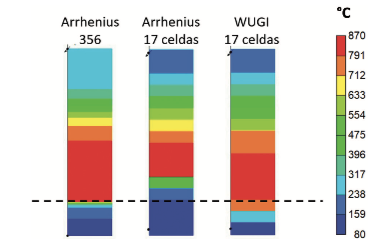Simplified alternative to model the kinetics of an in-situ combustion process

Published 2018-12-20
Keywords
- In situ combustion, kinetics, numerical simulation, heavy oil, combustion tube test, enhanced oil recovery (EOR), improved oil recovery (IOR).
How to Cite
Copyright (c) 2018 Revista Fuentes

This work is licensed under a Creative Commons Attribution 4.0 International License.
Abstract
In situ combustion (ISC) is an enhanced oil recovery (EOR) technique with great potential for application in heavy and extra-heavy oil fields; however, its implementation has been limited due to the high degree of uncertainty associated with its development at the field scale. Considering the level of complexity of the ISC process compared to other EOR / IOR techniques, to evaluate the technical feasibility of ISC in a specific reservoir will take far more complex screening methods and laboratory testing. Among the tests required to evaluate ISC include the kinetic cell tests, which are aimed at determining the oxidative behavior of the rock-fluid system under study, and in turn, allow obtaining a kinetic model that represents, by means of numerical modeling, the performance of the ISC process obtained experimentally in combustion tube tests. Based on the above, in the present work, the results obtained from the adjustment of a combustion tube test were compared using the Arrhenius and non- Arrhenius methodologies, evidencing significant differences in the computation time and in the residual oil saturation values in the porous medium after the implementation of the ISC process.
Downloads
References
Bazargan, M., Cinar, M., Glatz, G., Lapene, A., Zhu, Z., Castanier, L., Kovscek, A. R. (2011). A combined experimental and simulation workflow to improve predictability of in situ combustion. SPE 144599.
Belgrave, J. D., Moore, R. G., Ursenbach, M. G. y Bennion, D. W. (1993). A comprehensive approach to in situ combustion modeling. SPE Advanced Technology Series. 1 (1), 98 – 107.
Burger, J. G., y Sahuquet, G. C. (1972). Chemical Aspects of In Situ Combustion – Heat of Combustion and Kinetics. SPE Journal. 1 (5), 410 – 422.
Chen, B. (2012). Investigation of in situ combustion kinetics using the isoconversional principle. A Dissertation Ph. D Thesis. Stanford University. Stanford.
Chen, X.; Chen, Z.; Moore, R. G.; Mehta, S. A.; y Ursenbach, M. G. (2014). Kinetic Modeling of the In-Situ Combustion Process for Athabasca Oil Sands. SPE 170150.
Cinar, M. (2011). Kinetics of crude oil combustion in porous media interpreted using isoconversional methods. A Dissertation Ph. D Thesis, Stanford University. Stanford.
Crookston, R., Culham W., and Chen, W. (1979). A numerical simulation model for thermal recovery processes. SPE Journal. 19 (1): 37-58.
Eugono, A. (2010). Numerical simulation of chemical reaction of in situ combustion using SARA fraction. M.Sc. Thesis, Delft University of Technology.
Fassihi, M. R. (1981). Analysis of fuel oxidation in In Situ Combustion oil recovery. A Dissertation Ph. D Thesis. Stanford University. Stanford.
Freitag, N. P. y Exelby, D. R. (2006) A SARA based model for simulating the pyrolysis reactions that occur in high temperature EOR processes. Journal of Canadian Petroleum Technology. 45 (3), 38 – 44.
Glatz, G. (2012). Towards Field Scale In-Situ Combustion Simulation. A Dissertation M.Sc. Thesis. Stanford University. Stanford.
Hayashitani, M., Bennion, D. W., Donnelly, J. K. y Moore, R. G. (1978). Thermal cracking models for Athabasca oil sands. SPE Annual Fall Technical Conference and Exhibition Proceedings.
Khansari, Z. (2014). Low temperature oxidation of heavy crude oil: Experimental study and reaction modeling. A Dissertation Ph. D Thesis. University of Calgary. Calgary.
Padilla, J. M. (2016). Desarrollo de un modelo cinético a partir de análisis isoconversional para describir un proceso de combustión in situ. Tesis de Maestría, Universidad Industrial de Santander. Bucaramanga.
Pinzón, A. R. (2018) Efecto del flux de aire y las propiedades del medio poroso sobre la cantidad de combustible depositado en un proceso de combustión in situ. Tesis de Maestría, Universidad Industrial de Santander. Bucaramanga.
Sarathi, P. S. (1999). In situ Combustion Handbook.
Principles and Practices. (BDM Petroleum Technologies) NIPER/BDM-0374. Tulsa, Oklahoma.
Sequera, B., Moore, R. G., Mehta, S. A. y Ursenbach, M. G. (2010). Numerical simulation of in situ combustion experiments operated under low temperature conditions. Journal of Canadian Petroleum Technology. 49 (1), 55 – 64.
Zhu, Z. (2011). Efficient simulation of thermal enhanced oil recovery processes. A Dissertation Ph. D Thesis, Stanford University. Stanford.